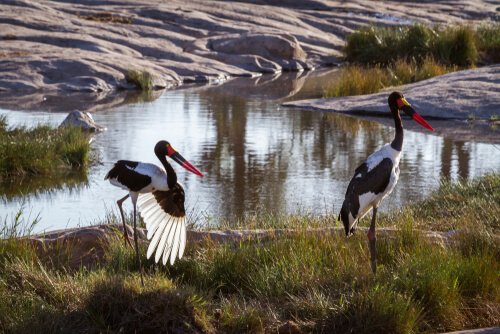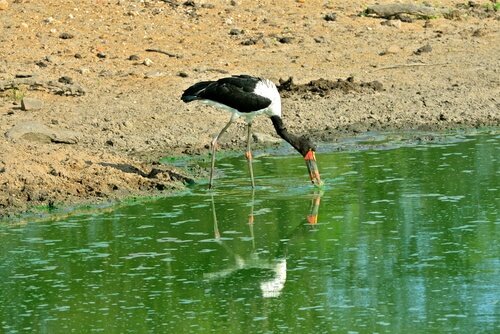Saddle stork habitat
It has a more than unique name and is a bird native to Africa. In this article we inform you about the jabiru or saddle stork, with its characteristic feathers.
Where does the saddle stork live?
Its scientific name is quite difficult to pronounce and remember, but we can call it saddle stork or African jabiru. It is a wader that belongs to the family of storks and that spans several parts of Africa.
We can find colonies of this species throughout the sub-Saharan area of the continent , which includes Sudan, Ethiopia, the Gambia, Kenya, Senegal, Cote d'Ivoire and Chad. In addition, it is one of the many animals that can be found in the Kruger National Park of South Africa.
It prefers habitats with freshwater mirrors, such as rivers, lagoons, wetlands and salt marshes . It can be seen in open areas and wooded meadows. Its distribution has been altered due to human activities: its main threats are the drainage of wetlands and the creation of agricultural land where once were wild areas.
How is the saddle stork?
It is a large bird, which can reach 150 centimeters high and a wingspan of almost two and a half meters . Mainly, the height is due to its long legs, up to 60 centimeters, black with pink 'spots'.

The males are larger and heavier than the females, and can reach seven kilos (the female samples do not exceed five kilos). Other ways to distinguish between sexes is that they have browns and gold irises.
Both the female and the male have more than pretty fur: head, neck , back, wings and tail are black and the rest of the feathers are white. In the case of young specimens they have grayish plumage.
In addition, they stand out in this bird their beak long, red and black with a yellow spot on the top and the red 'patch' at chest height, which darkens during the breeding season. p>
What does the saddle stork eat and how does the stork reproduce?
The saddle stork feeds on fish, frogs and crabs, although it can sometimes add the diet small birds and reptiles. To hunt, it moves delicately and majestically over the waters and, when it detects a prey, it quickly captures it with its long and powerful beak.
With regard to reproduction, choose areas with deeper water - for example, as a result of a flood - and build the nest, deep and large, near the trees.

The females lay between one and two white eggs that can weigh up to 150 grams each . The incubates approximately during a month and during all that time the male is in charge to feed it. After hatching, the chicks need almost three months to be prepared for life without their parents.
It is worth noting that the saddle stork does not form breeding colonies, but that specimens come together in pairs, away from the rest.
What are the main behaviors of the saddle stork?
This bird needs to stay fresh all the time and, if possible, with several hours of shade during the day. To avoid reheating the body, it bristles its feathers and 'separates' them from the belly. Also, fill the beak with water and throw it on top of the eggs or chicks.It even has a special hieroglyph and a specific phonetic value. Even a pharaoh of the Khaba dynasty used this bird to form his name after being crowned!


